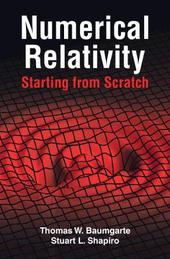
|
Numerical Relativity: Starting from Scratch
Paperback / softback
Main Details
| Title |
Numerical Relativity: Starting from Scratch
|
| Authors and Contributors |
By (author) Thomas W. Baumgarte
|
|
By (author) Stuart L. Shapiro
|
| Physical Properties |
| Format:Paperback / softback | | Pages:234 | | Dimensions(mm): Height 230,Width 151 |
|
| Category/Genre | Cosmology and the universe
Relativity physics |
|---|
| ISBN/Barcode |
9781108928250
|
| Classifications | Dewey:530.11 |
|---|
| Audience | | Tertiary Education (US: College) | | Professional & Vocational | |
|---|
| Illustrations |
Worked examples or Exercises
|
|
Publishing Details |
| Publisher |
Cambridge University Press
|
| Imprint |
Cambridge University Press
|
| Publication Date |
8 April 2021 |
| Publication Country |
United Kingdom
|
Description
Numerical relativity has emerged as the key tool to model gravitational waves - recently detected for the first time - that are emitted when black holes or neutron stars collide. This book provides a pedagogical, accessible, and concise introduction to the subject. Relying heavily on analogies with Newtonian gravity, scalar fields and electromagnetic fields, it introduces key concepts of numerical relativity in a context familiar to readers without prior expertise in general relativity. Readers can explore these concepts by working through numerous exercises, and can see them 'in action' by experimenting with the accompanying Python sample codes, and so develop familiarity with many techniques commonly employed by publicly available numerical relativity codes. This is an attractive, student-friendly resource for short courses on numerical relativity, as well as providing supplementary reading for courses on general relativity and computational physics.
Author Biography
Thomas W. Baumgarte is the William R. Kenan Jr. Professor of Physics at Bowdoin College in Brunswick, Maine. His work in numerical relativity and relativistic astrophysics has been recognized with prizes and fellowships from the Guggenheim Foundation, the Humboldt Foundation, the American Physical Society, and the Simons Foundation. Stuart Shapiro and he have previously co-authored the graduate-level text Numerical Relativity: Solving Einstein's Equations on the Computer (Cambridge, 2010). Stuart L. Shapiro is a Professor of Physics and Astronomy at the University of Illinois at Urbana-Champaign. He is a leading scientist in theoretical astrophysics and general relativity and has been awarded numerous prizes and honors for his research and teaching, including Sloan and Guggenheim fellowships, IBM Supercomputing awards, and the Hans A. Bethe Prize of the American Physical Society, where he was elected Fellow. Shapiro has published over 400 research papers and, in addition to his writing with Thomas Baumgarte, he is co-author of the classic text Black Holes, White Dwarfs and Neutron Stars: The Physics of Compact Objects (1983).
Reviews'Computational general relativity has now become a central tool for the exploration of the astrophysical universe, and gravitational-wave astronomy would not be possible without it. A burgeoning or seasoned astrophysicist who wishes to be up to date must therefore acquire an awareness of the field's methods and main achievements. But where to begin? With this book! Baumgarte and Shapiro are leading experts (indeed, founding experts) of this field, and with their trademark lucid and engaging prose, they take us gently by the hand on a comprehensive guided tour. Mysterious notions (lapse, shift, extrinsic curvature, constraint equations) are introduced seamlessly, and the book features a gallery of the field's most important results to date. A superb achievement for the great benefit of the scientific community.' Eric Poisson, University of Guelph; author of A Relativist's Toolkit 'Numerical relativity well deserves its reputation as a subject of great beauty yet prodigious conceptual difficulty and daunting technical complexity. This outstanding text, by two leading practitioners of the field, is a wonderful Rosetta Stone for those seeking an efficient path toward a working knowledge of the subject. For me it will serve as an essential reference. I'm sorry only that it was not available sooner.' Robert Eisenstein, Massachusetts Institute of Technology 'This is an excellent book explaining the general relativistic two-body problem and its numerical treatment in a highly pedagogical manner to a broad scientific audience. Besides the main topic, readers will also gain some unexpected insight and new viewpoints on numerous wider aspects of Einstein's theory.' Ulrich Sperhake, University of Cambridge 'Black holes and gravitational waves are, thanks to new observations, fast-advancing frontiers of astronomy that attract wide interest. Their implications are best addressed by powerful computers, so this text, by two acknowledged world experts, is especially welcome and timely.' Martin Rees, Astronomer Royal; author of Gravity's Fatal Attraction
|